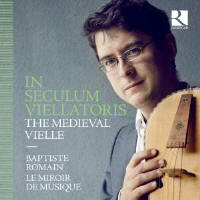Texte paru dans: / Appeared in: |
|
|
Outil de traduction ~ (Très approximatif) |
|
|
Reviewer: Charles
Brewer The amount of surviving notated music for instruments from the Middle Ages is rather small. As research has continued over the past few decades, the increasing iconographical and literary evidence that has been discovered clearly indicates that instruments were used extensively in many types of music making, from accompanying songs to dance music. In these same decades the quality of both instruments and knowledge of performance styles has improved significantly. In playing the medieval vielle, Sterling Jones of the Studio der Frühen Musik began to look at the practices of traditional musicians, which influence many of the following generations of players (medieval dances, reissued on Teldec in 1988).
Jordi Savall devoted three recordings to music for the vielle (J/A 1996: 263, S/O 2008: 227, M/A 2015: 216), often using both traditional folk versions of the vielle and other bowed string instruments. Baptiste Romain is from the next generation and this new release documents how much has improved in both the reproduction of the instruments and the ability of modern performers. The music ranges from medieval dance music (‘La uitime estampie Real’ from 13th Century France and ‘Belicha’ and ‘Ghaetta’ from 14th Century Italy) through instrumental versions of songs and motets (such as ‘Bele Ysabelot/Je me cuidoie/ Entre Copin’, Johannes Ciaconia’s ‘O rosa bella’, and the anonymous ‘J’aime la biauté’) to the use of the vielle to accompany singers (Perdignon’s ‘Tut l’an mi ten amors’, Guillaume Dufay’s ‘Le belle se siet’, and the anonymous ‘Ar ne kuthe ich sorghe’, ‘Non credo, donna’, and ‘Soyés loyal’). The title of the collection refers to a 13th Century polyphonic motet copied without words, based on a chant fragment, ‘In seculum’, but with “of the vielle player” added to the title, and Romain’s interpretation on a rubeba (another traditional bowed string instrument) accompanied by two other vielles is perhaps the best I have heard over the years. In all the roles assumed by Romain on this new release, whether soloist, ensemble performer, or vocal accompanist, he demonstrates his musical sensitivity and taste. He now teaches the vielle at the Schola Cantorum Basiliensis where many years before Sterling Jones had taught, and this recording documents that Jones’s legacy is in very good hands. | |
|
Support us financially by purchasing this disc from eiher one of these
suppliers. |
|
|
|
|
|
Cliquez l'un ou l'autre
bouton pour découvrir bien d'autres critiques de CD |
|




